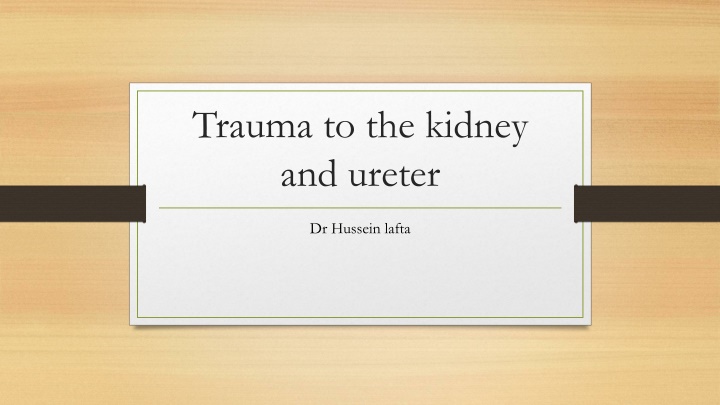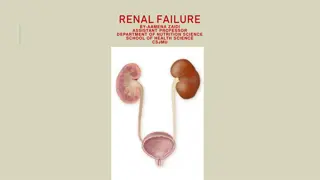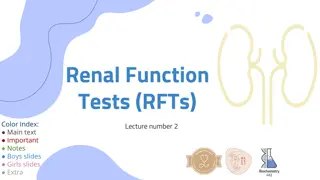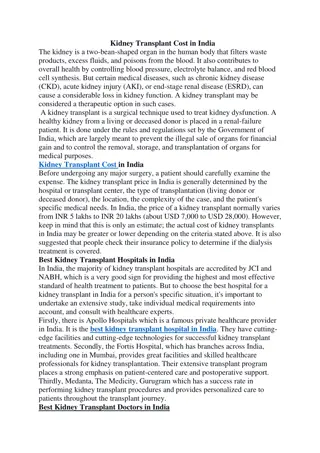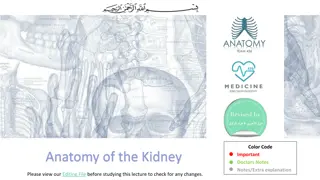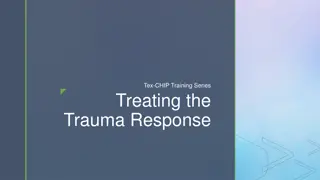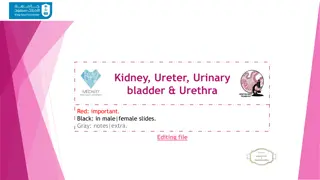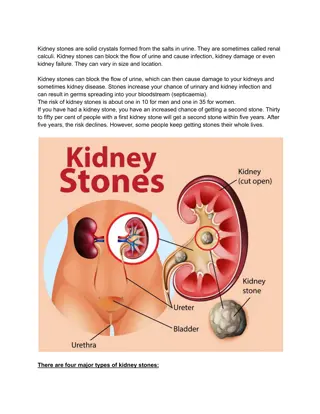Trauma to Kidney and Ureter
Trauma to the kidney and ureter can result from various causes such as interpersonal violence, accidents, or self-inflicted injuries. Blunt and penetrating mechanisms of renal injury can lead to clinical features like flank trauma and hematuria. Minor injuries may require rest and monitoring, while major renal trauma may necessitate hospital admission, hydration, and close monitoring of vital signs. Radiological evaluations and treatments tailored to the severity of the trauma are essential in managing these cases.
Download Presentation

Please find below an Image/Link to download the presentation.
The content on the website is provided AS IS for your information and personal use only. It may not be sold, licensed, or shared on other websites without obtaining consent from the author.If you encounter any issues during the download, it is possible that the publisher has removed the file from their server.
You are allowed to download the files provided on this website for personal or commercial use, subject to the condition that they are used lawfully. All files are the property of their respective owners.
The content on the website is provided AS IS for your information and personal use only. It may not be sold, licensed, or shared on other websites without obtaining consent from the author.
E N D
Presentation Transcript
Trauma to the kidney and ureter Dr Hussein lafta
Defenition Trauma is define as a physical injury or a wound to the living tissue caused by extrinsic agent, 1- interventional : either interpersonal violence related,war, related or self-inflicted injury. 2- uninterventional injury: mainly motor vehile collision ,falls, and other domestic accidents
Mechanism of renal injury: I-blunt renal trauma ---------60-90%. e.g. direct blow , fall from height ,motor vehicle accident,sport inj.,ESWL II- penetrating trauma; e.g. stab inj. war inj., gun shut inj., PCNL, renal biopsy. Dr.Hussein Lafta
Clincal feature Hx of trauma. -evidence of flank trauma{e.g.rib fracture,flank ecchymosis} -heamaturea{mic . or gross heam.} -heamodynamic instability{B\P<90mhg.} Dr.Hussein Lafta
Minor inj.------90% Contusion and shallow laceration limited to the renal cortex Major inj.------10% : A- pedicle: I-tear or laceration of segmental or major renal art. II-occlusion of seg. Or major ren.art. B - non-ped.: Laceration extending through the corticomedularry junction with or without envolvment of collection system. Classification Dr.Hussein Lafta
Investigation -I.V.U, spiral C.T{enhanced and nonenhanced} Indication for radiological evaluation{for adult} -gross heamaturea -Microscopical heamt.+shock{B\P<90}. -Microscopical heamt. + multisystem inj. Dr.Hussein Lafta
Indication{for children} -Deceleration -Microscopical heamt. + {R.B.C>50/h.p.f} -gross heamt. -rib fracture This is bec. That the pediatric kid. Are at higher risk of sustaining trauma: -more mobile -less protected by perirenal fat. -relatively larger than audult kid Dr.Hussein Lafta
Treatment I-Minor renal trauma: -Admission to the hospital until urine become clear. -complete bed rest. -antibiotic. Dr.Hussein Lafta
Treatment {continue} II-Major renal truama: A-Blunt non pedicle: -admission to the hosp. -good hydration -complete bed rest. -close monitoring of vital sign. -blood transfusion on need. -exploration if vascular instability persist inspite of blood transfusion. Note :urinary extravastion per se is not an indication for exploration unless sepsis or persistent extravasation . Dr.Hussein Lafta
Treament{continue} B-Blunt pedicle truama: I -laceration-----immediate surgical exploration II-oclussion: -branch or segmental-----------observation -bilateral occlusion--------immediate exploration+ revasculartion. -unilateral occlussion with normal contralateral kid.---------observation with close follow up for bl .pr .,if hypertension develop then nephrectomy Dr.Hussein Lafta
Treatment{continue} Penetrating trauma: i-gunshot wound ----always exploration bec.of asso. Multiorgan inj. ii-stab wound: a-stab w. occurring ant. To the mid axillary line that mean penetrating peritoneal cavity-----exploration. b-stab wound that occurring post. To the mid axillary line + -ve peritoneal lavage+superficial laceration to the kid.{as proven by C.T}-----observation. * Dr.Hussein Lafta
Ureteral Injury Mechnism: -Iatrogenic: -endoscpy of the ureter -gynecological surgery -major abdominal surgery -gunshut. -stab wound. note: blunt trauma extremely rare to be cause uretral inj Dr.Hussein Lafta
Type of ureteral inj. -ligation---- during surgery. -crushing---- by clamp. -perforation---- during endoscopy. Dr.Hussein Lafta
Clincal features -urinary fistula -in case iatrogenic trauma: -prolong adynamic ileus -persistent flank pain -palpable abd. Mass -elevation of bl. urea -persistent drainage from operative drainge site. Dr.Hussein Lafta
Radiological features -delayed or non-visualzation of the involve renal unit. -hydronephrosis. -Urinary extravasation -icomplete visualization of the entire ureter Dr.Hussein Lafta
Treatment If the ureter ligated during surgery: A- if discover at time of surgery--- deligation. B - if discover bet 24-72hr.--- deligation+stent C- if descover >72hr.---resection of the ligated segment and to end anastmosis over a stent for 6wks. Dr.Hussein Lafta
Substitution for the ureter - ileum if large segment of the ureter lost - downword mobilization of the kid.+ upward mobilization of the bladder + Boari flap. - Synthetic tube Dr.Hussein Lafta
